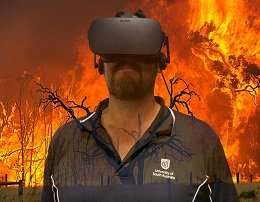Credit: University of South Australia
University of South Australia researchers and the SA Country Fire Service (CFS) have joined forces to give residents a searing experience of a bushfire – all from the safety of a virtual reality headset.
The new technology allows people to 'live through' a computer-generated scenario of a major bushfire in the Adelaide Hills, replicating fire conditions and strong, changeable winds fanning the flames, putting users under pressure to put their bushfire emergency plans into action.
The virtual reality headset, developed by UniSA PhD student Safa Molan in conjunction with CFS officials, simulates typical conditions in a bushfire, where residents must decide whether to leave their homes early or stay and defend.
Safa's supervisor, Associate Professor Delene Weber, says the virtual reality experience allows people to experience some of the emotional pressures of a fire, and the reality that conditions can change quickly.
"The scenario is realistic but safe and underlines the importance of being prepared in the event of a major fire," she says.
The technology is timely, given the findings of a recent study which showed that SA residents living in fire prone areas need to shift their focus from a survival plan to creating and managing a 'fire-smart' landscape, as urban growth in Adelaide's fringes continues unchecked.
The joint UniSA and University of Adelaide-led study explored the community's perceptions of vegetation management in peri-urban areas.
The study exposed the conflicts between fire control measures and biodiversity, revealing that modern planning processes have failed to address the complexity of environmental factors on the peri-urban fringe.
Assoc Prof Weber, from UniSA's Natural and Built Environments Research Centre, says almost 1000 people living in fire prone areas were surveyed and hundreds more interviewed in focus groups.
"Some key themes emerged," she says, "including the reality that it is becoming increasingly difficult to insulate people and assets from bushfire risk in South Australia.
"A balanced approach to risk mitigation and biodiversity protection is possible but there are clear differences between men and women in their ecological values, fire-risk assessment, preparation and response."
Current bushfire planning needs to acknowledge not only physical preparedness but also emotional preparation, Assoc Prof Weber says.
A report of the three-year study, which was funded by the Australian Research Council (ARC), includes the following findings and recommendations:
- 63 per cent of respondents believe that climate change and bushfire risk are linked, yet value biodiversity over burn offs and large vegetation clearance;
- More focus needs to be put on fire-smart communities who manage their landscapes rather than just putting a survival plan into action;
- Despite advances in individual landholder preparedness for bushfires, overall the community in peri-urban areas is unprepared;
- Fire management agencies need to have a strong voice in the early stages of new developments.
Provided by University of South Australia
























